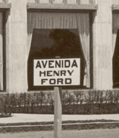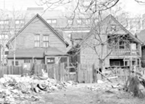
From Motor City to Motor Metropolis: How the Automobile Industry Reshaped Urban America
Downsizing: Depopulation, Disinvestment, and the Fate of the City
The spread of the auto industry outward in the 1950s was but a first stage in the mass migration of industry to low-wage regions of the United States and, increasingly, the world. Many manufacturing concerns related to the auto industry moved further afield to the South and to Mexico and Canada, particularly in the 1970s and 1980s. And one by one, major auto plants in Detroit shut their doors.
The decentralization of industry had profound effects on the urban geography and on the working-class population of the city. The movement of jobs out of the city accelerated the process of suburbanization, as autoworkers who could move followed their jobs. Hardest hit by the loss of jobs in the central city were black workers, who could seldom find housing in the segregated suburbs or the mostly white small towns that attracted many firms. In the 1960s, social scientists began to observe what they called a "spatial mismatch," between working-class minorities and jobs. Most jobs were being created in outlying communities that excluded minorities. Getting from the central city to an outlying plant was time-consuming and costly. Those who hung onto their jobs often had to commute long distances. But given the lack of good public transportation connecting the city and new suburban job sites, workers needed reliable cars. Yet inner city residents were far less likely than their white, suburban counterparts to own their own cars. In a vicious circle, those who lived in places abandoned by the auto and related industries and who were frozen out of suburban housing markets had to rely on the most expensive form of private transportation (because of public transit cuts) to get to jobs.
The downsizing and shutdown of central city factories devastated urban neighborhoods. The small shops, bars and restaurants that catered to workers during their lunch breaks or at shift change shut their doors. Neighborhoods near closed plants lost population. Without convenient jobs--and with the hulks of old plants looming over them--they became less desirable places to live. Cities like Detroit struggled to recoup the tax revenues that they lost when companies closed their doors. The loss of property taxes, wage taxes, and population was devastating, particularly as urban governments faced the costs of providing education and social services to an increasingly impoverished population. The environmental impact of factory shutdowns was also grave. Redeveloping brownfields, as disused factory sites were called, became difficult because of the residue of decades of industrial waste left behind.
A trip through the streets of the city by the mid-1960s revealed the wrenching impact of auto mobility. What had been some of the densest sections of the city were now a veritable wasteland, pockmarked by empty storefronts, rubble-strewn vacant lots, and boarded up houses. The neighborhoods hardest hit--most emptied out--were the city's oldest and those neighborhoods that abutted now closed-down factories. Highland Park and Hamtramck, which relied heavily on Chrysler, lost half their population after 1960. Large parts of Detroit's east side, home to generations of German, Polish, and Slavic autoworkers saw massive depopulation and abandonment. The Delray neighborhood, home to many of the city's most prominent Hungarian churches, lost nearly ninety percent of its population, as many of the area's auto, steel, and chemical plants downsized their workforces or shut their doors altogether.
The flight of industry outward was ultimately made possible by the car itself. In the eighteenth and nineteenth centuries American cities grew up along rivers and canals, which linked them to markets well beyond their boundaries. From the mid-nineteenth to the mid-twentieth centuries, railroads became the threads that connected cities, their industries and suppliers, and their people. But from the 1920s onward, highways became the lifeblood of the metropolis and, increasingly, cars and trucks carried goods and people from place to place. Detroit recapitulated that history: it came to life as a river city, grew as an industrial colossus in the era of the railroad (auto plants were almost always constructed along railroads, which brought raw materials in and finished vehicles out). And by the 1950s, the city's economy traveled outward as highways--and after 1956, federally-subsidized interstate freeways--made it possible for industry to move away from rivers and railroads.
In the 1970s and the 1980s, the auto industry fell on even harder times, as it struggled to overcome economic woes that grew combination of oil shortages, rising fuel prices, and intense international competition, particularly with auto manufacturers in Japan and Germany. In the late 1970s, Chrysler nearly went bankrupt (only to be bailed out by the federal government), and Ford and General Motors suffered record losses. The auto industry's woes exacerbated the effects of nearly a quarter century of deindustrialization and job loss.
Counteracting decades of industrial flight proved to be difficult and costly. In the 1980s, city officials used the power of eminent domain to demolish the Poletown neighborhood (which adjoined the site of the once mighty Dodge Main plant, which had closed in 1980) for the construction of a suburban-style Cadillac plant. In the 1990s--again with massive government subsidies--Chrysler built a new plant on the city's East Side. But the dense urban fabric that surrounded older plants was gone. For example, the new Poletown plant employed fewer than 2,000 workers, too small a number to sustain the bars, stores, and restaurants that surrounded many older, larger facilities. Most Poletown workers drove to work and quickly left the neighborhood on the two expressways that passed nearby.
By the end of the twentieth century, the auto industry remained Detroit's dominant employer and, indeed, one of the leading sectors of the national economy. But auto industry employees were less and less a part of the picture of the sprawling metropolis of the late twentieth century. The absolute number of auto industry employees fell between 1950 and 1990. At mid-century, 214,000 Detroit men worked in blue-collar manufacturing jobs; by 1990, the figure had fallen to only 104,000. The color of auto industry employees also got whiter over the last half of the twentieth century, as manufacturing jobs disappeared and as the auto industry became more bureaucratic in its organization. In 1950, the auto industry employed 26 white collar workers for every 100 blue-collar workers; in 1990, it employed 63 white-collar workers for every 100 blue-collar workers. While assembly line workers did not disappear, "shop rats" (as they often called themselves) became less and less common. The trend shows little signs of abating. As American auto manufacturers scrambled to keep up with their European and Asian competitors and began to hold their ground in the 1990s, they introduced new labor-saving technologies that further reduced assembly-line jobs. As a result auto industry productivity rose rapidly in the 1990s, even as auto industry employment continued to fall. Replaced by machines or by workers in other parts of the country or other parts of the world, many blue-collar Detroiters moved into service-sector jobs that were less-well paying and secure than the auto industry. At century's end, the Motor City remains the headquarters of three of the world's most gigantic firms, but fewer and fewer working-class Detroiters depend on auto-industry wages for their livelihood.
Over the course of the twentieth century, the auto industry remade modern America--and indeed the world. From humble origins in the late nineteenth century, the auto industry grew explosively in the early and mid-twentieth centuries, scattered and decentralized, and reconstituted its work force. The impact on everyday life--from where people live to what kind of work they do--cannot be underestimated. Those changes were especially visible in Detroit, the capitol of the auto industry. Over the course of a century, the Motor City had become the Motor Metropolis, going from a few square miles to a few thousand square miles in under a century. It was made, remade, and unmade by its dominant industry. Its human geography--of race, class, and power--is the unique product of the automobile age. And its built and natural environments are also the product and by-product of the car itself. At the dawn of a new century, amidst celebrations of the advent of the new, revolutionary technology of the computer and the internet (dubbed the electronic superhighway), we are still a nation of cars, of highways, of sprawl, of industrial decentralization. We still live in the automobile nation.
<<Previous Section - Next Section>>
Becoming the Motor City: Immigrants, Migrants, and the Auto Industry
Living in the Motor City: Autoworkers, Race, and Urban GeographyBuilding the Motor Metropolis: Automobiles, Highways, and Sprawl
Moving Out: Decentralization and the Decline of Urban Factories
Downsizing: Depopulation, Disinvestment, and the Fate of the City
Complete Text Printable View
About the Project | Credits | Contact Us | Student & Teacher Resources | Site Map
©2004 Automobile in American Life and Society




